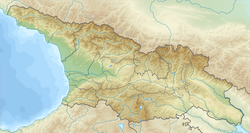Pasanauri
Pasanauri
Georgian: ფასანაური | |
|---|---|
 Pasanauri in the 1870s | |
| Coordinates: 42°20′47″N 44°41′34″E / 42.34639°N 44.69278°E | |
| Country | |
| Mkhare | Mtskheta-Mtianeti |
| Municipality | Dusheti |
| Elevation | 1,050 m (3,440 ft) |
| Population (2014) | |
• Total | 1,148 |
| Time zone | UTC+4 (Georgian Time) |
Pasanauri (Georgian: ფასანაური, also spelled Passanauri) is a small town (daba) in Georgia, situated in the Dusheti district, Mtskheta-Mtianeti region.
Pasanauri lies about 90 kilometres (56 mi) north of the nation's capital of Tbilisi,[1] at elevation of 1,050 m. above sea level.[2] Located on the Georgian Military Road, Pasanauri is flanked by the Aragvi River,[3] and surrounded by the Caucasus Mountains. Average winter temperature is 0 degrees Celsius, but often falls below 10 degrees Celsius. As of the 2014 census, the townlet had a population of 1,148.
Due to its picturesque location and the proximity to nearby historical sites as well as for its mineral water, hiking routes, handcrafted items and food, Pasanauri became a popular tourist destination in the Soviet period,[4] but suffered decay during the years of post-Soviet crisis.
Climate
[edit]Pasanauri's climate is humid continental(Köppen climate classification: Dfb, Trewartha climate classification: Dcbo) with warm summers and cold winters. 14.4 days per year have a maximum temperature above 30 °C (86 °F), while 115.3 days have minimum temperature below freezing.[5]
From November to April, there are 73.1 days on average with snow cover, of which 45.9 days have at least 10 cm (3.9 in) of snow depth.[5]
| Climate data for Pasanauri (1991–2020, extremes 1981-2020) | |||||||||||||
|---|---|---|---|---|---|---|---|---|---|---|---|---|---|
| Month | Jan | Feb | Mar | Apr | May | Jun | Jul | Aug | Sep | Oct | Nov | Dec | Year |
| Record high °C (°F) | 11.9 (53.4) |
15.5 (59.9) |
22.9 (73.2) |
28.5 (83.3) |
33.0 (91.4) |
32.5 (90.5) |
36.0 (96.8) |
37.0 (98.6) |
36.0 (96.8) |
28.0 (82.4) |
24.0 (75.2) |
17.7 (63.9) |
37.0 (98.6) |
| Mean daily maximum °C (°F) | 2.5 (36.5) |
4.8 (40.6) |
9.4 (48.9) |
15.0 (59.0) |
19.6 (67.3) |
23.8 (74.8) |
26.5 (79.7) |
26.7 (80.1) |
22.2 (72.0) |
16.8 (62.2) |
9.6 (49.3) |
4.0 (39.2) |
15.1 (59.2) |
| Mean daily minimum °C (°F) | −6.4 (20.5) |
−5.5 (22.1) |
−1.2 (29.8) |
3.6 (38.5) |
7.7 (45.9) |
11.2 (52.2) |
14.0 (57.2) |
13.8 (56.8) |
9.9 (49.8) |
5.4 (41.7) |
−0.4 (31.3) |
−4.5 (23.9) |
4.0 (39.2) |
| Record low °C (°F) | −21.0 (−5.8) |
−20.0 (−4.0) |
−17.3 (0.9) |
−10.4 (13.3) |
−2.0 (28.4) |
3.0 (37.4) |
6.0 (42.8) |
6.0 (42.8) |
−0.7 (30.7) |
−5.8 (21.6) |
−13.0 (8.6) |
−20.5 (−4.9) |
−21.0 (−5.8) |
| Average precipitation mm (inches) | 45.9 (1.81) |
42.8 (1.69) |
68.7 (2.70) |
97.0 (3.82) |
139.5 (5.49) |
120.6 (4.75) |
93.8 (3.69) |
85.7 (3.37) |
71.4 (2.81) |
80.1 (3.15) |
52.7 (2.07) |
42.0 (1.65) |
940.2 (37) |
| Average precipitation days (≥ 1.0 mm) | 5.6 | 6.1 | 7.8 | 11 | 13.7 | 11.8 | 8.6 | 8.2 | 7.3 | 7.8 | 5.7 | 5.3 | 98.9 |
| Source: NCEI[5][6] | |||||||||||||
See also
[edit]References
[edit]- ^ Dubinskaya, Lidiya (1985). The Soviet Union. Raduga Publishers. p. 274. Retrieved 2008-10-18.
- ^ "Pasanauri". WeatherOnline. Retrieved 2008-10-18.
- ^ Ghambashidze, David (2007). Mineral Resources of Georgia and Caucasia - Manganese Industry of Georgia. READ BOOKS. p. 101. ISBN 978-1-4086-2831-7. Retrieved 2008-10-18.
- ^ Javaxišvili, Alekʻsandre; Georgiĭ Grigorʹevich Gvelesiani (1969). Soviet Georgia. Progress Publishers. p. 162. Retrieved 2008-10-18.
- ^ a b c "World Meteorological Organization Climate Normals for 1991–2010: Pasanauri-37432" (CSV). ncei.noaa.gov. National Centers for Environmental Information. Retrieved 18 March 2024.
- ^ "World Meteorological Organization Climate Normals for 1981–2010: Georgia". National Centers for Environmental Information. p. 7. Archived from the original on 9 October 2021. Retrieved 9 October 2021.


